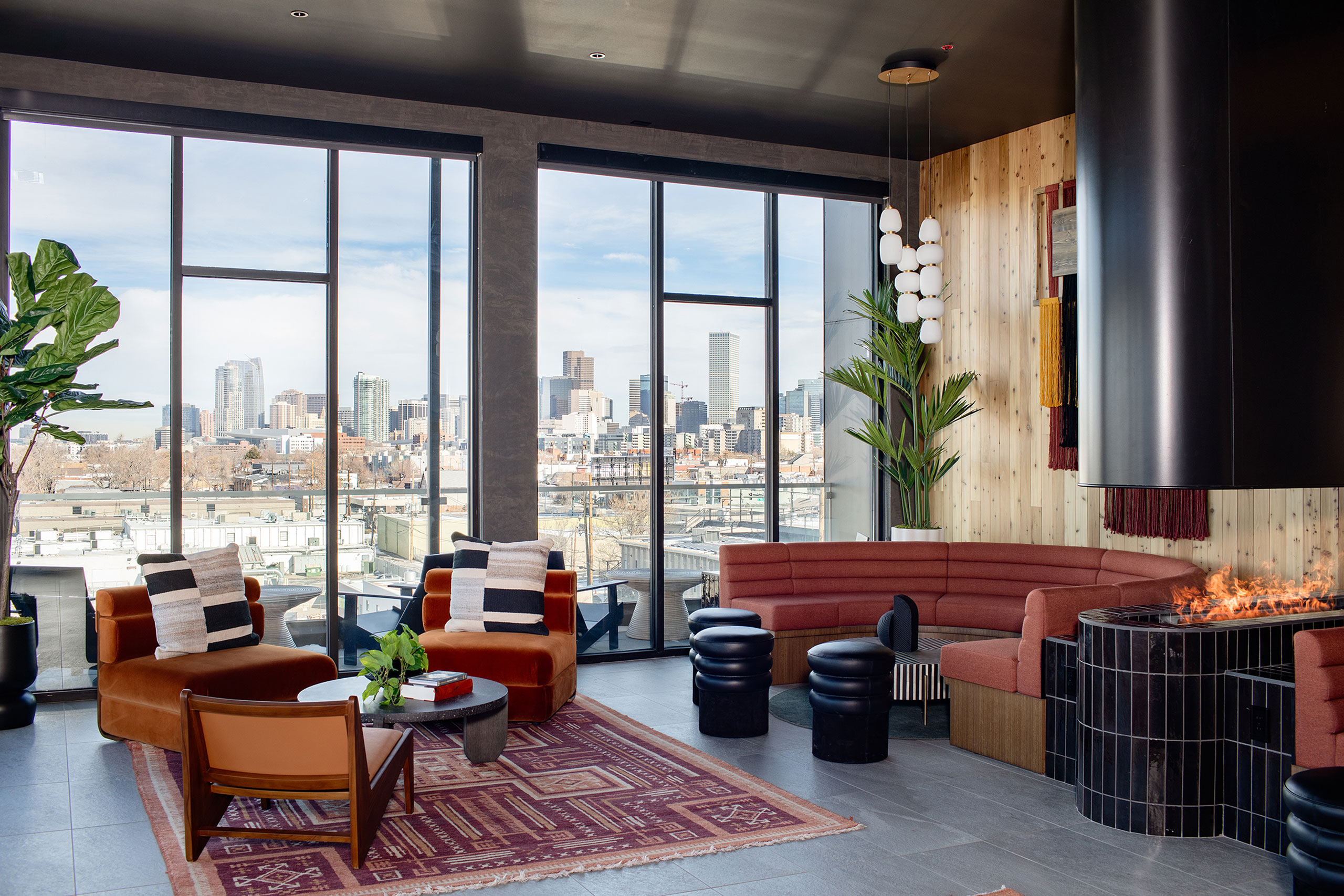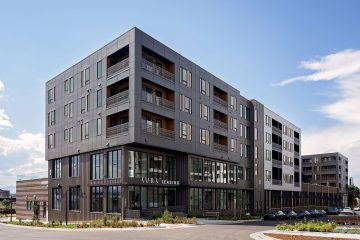 Featuring wall-to-ceiling windows and a connected outdoor patio, Aura Arts District’s sky lounge provides a modern space with stunning skyline views.
Featuring wall-to-ceiling windows and a connected outdoor patio, Aura Arts District’s sky lounge provides a modern space with stunning skyline views.
Just west of Denver’s Santa Fe arts district, the newly opened Aura Arts multifamily development marks a subtle but meaningful turning point in Colorado’s urban evolution. Located at 505 Lipan St., Aura is more than a place to live; it reflects both the creative identity of its surrounding neighborhood and the growing influence of artificial intelligence on real estate development.
While narrowly outside the arts district boundary, KTGY’s design aligns Aura with its creative energy through an engaging street presence. Known for galleries and First Friday Art Walks, the popular district is navigating a surge of growth, with attendant challenges around affordability and authenticity. Aura’s position on the western edge of the district gave our design team the chance to bridge legacy and innovation at this physical threshold where art meets growth.
Urban infill meets intelligent development.
Aura was developed as a strategic infill project on a former industrial site, bringing high-density housing to a transit-connected area. It aligns with Denver’s broader push for compact, walkable urban development. What sets Aura apart is how it exemplifies the shift in technological integration with the development process over the span of just one development’s lifetime.
Smarter systems and streamlined operations.
AI continues to add value after construction ends, enhancing both operations and resident experience. Predictive maintenance tools, automated leasing workflows and AI-driven support platforms are a growing standard in efficient property management. At Aura, seamless Wi-Fi throughout both buildings enables uninterrupted access to smart features – residents can adjust thermostats, receive package alerts and submit maintenance requests from anywhere on-site. During a leasing tour, I interacted with Ivy Lane, the virtual leasing assistant, an increasingly common yet impactful tool in the initial stages of leasing. These aren’t just tech perks. They’re reshaping expectations for how multifamily properties are managed and experienced.
From passive design to predictive modeling.
Much of our work on Aura relied on time-tested sustainable principles: orienting the pool courtyard south to capture natural light, configuring massing to block prevailing winter winds and leveraging passive strategies to reduce energy loads. These foundational moves prioritize resident comfort and environmental performance through site-responsive design.
Today, emerging AI tools offer opportunities to take sustainable design strategies even further, allowing designers to turn qualitative insights into quantitative evaluations. If we were to design Aura today, our team would employ AI simulations, in addition to best practices, to model acoustic impacts from the nearby West Sixth Avenue freeway and optimize the building’s orientation and facade treatments accordingly. Similarly, predictive tools could assess microclimatic conditions in courtyard spaces, identifying plant species most likely to thrive based on sun exposure, wind patterns and soil conditions.
Where design decisions were once guided largely by experience and intuition, AI now enables a new level of precision – allowing sustainability goals to be validated, refined and optimized through user-friendly and accessible modeling and data analysis tools.
At the intersection of culture and computation.
Aura’s location brings it into dialogue with more than just building science. A few blocks away, local artists continue working with paint, clay and analog media, while new generations explore generative AI, algorithmic design and digital art. Aura is a physical manifestation of that convergence: a building on the brink of culture and computation.
This raises important questions for developers and civic leaders alike: How can we use technology to amplify cultural expression, not erase it? How do we retain neighborhood identity while embracing innovation? These aren’t just abstract ideas, they’re shaping the trajectory of how cities grow.
A signal of what’s to come.
Aura Arts signals where development is heading in Denver and beyond. What the team accomplished with our design is a synergy between organic design elements and tech integration. Aura’s new residents can message the building’s AI platform from the snug, timber-backed hearth in their building. They can return home from an art walk and access their units without fumbling for the keys. This kind of experience-first tech integration enhances engagement by taking away daily friction and connects residents more deeply with the art and natural beauty around them.
As Colorado’s real estate market continues to grow, the challenge is to build not just faster and smarter, but with more meaning. Projects like Aura point to what’s possible when technology is applied with context, care and creativity, offering a glimpse of a future where real estate strategy and cultural sensitivity go hand in hand.

